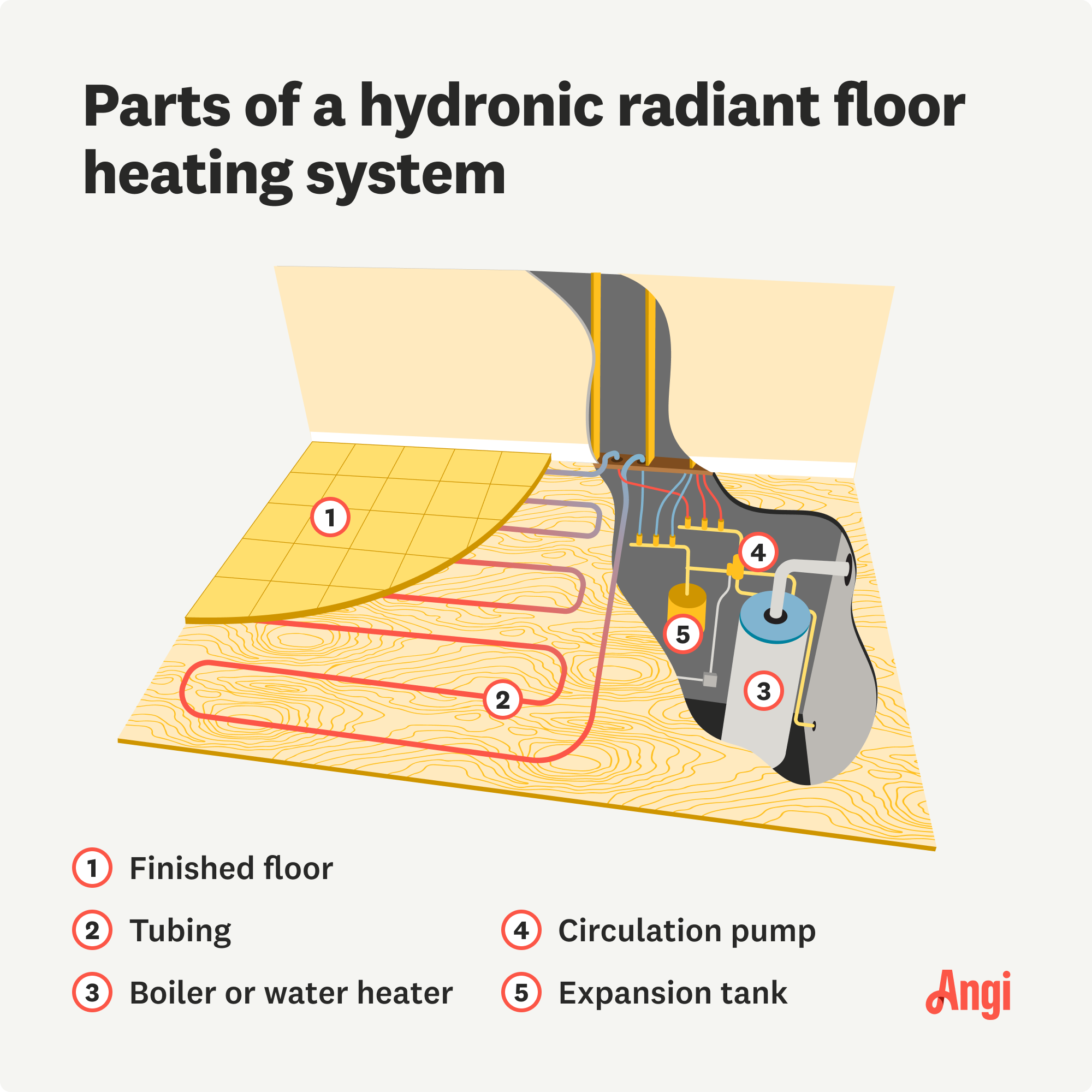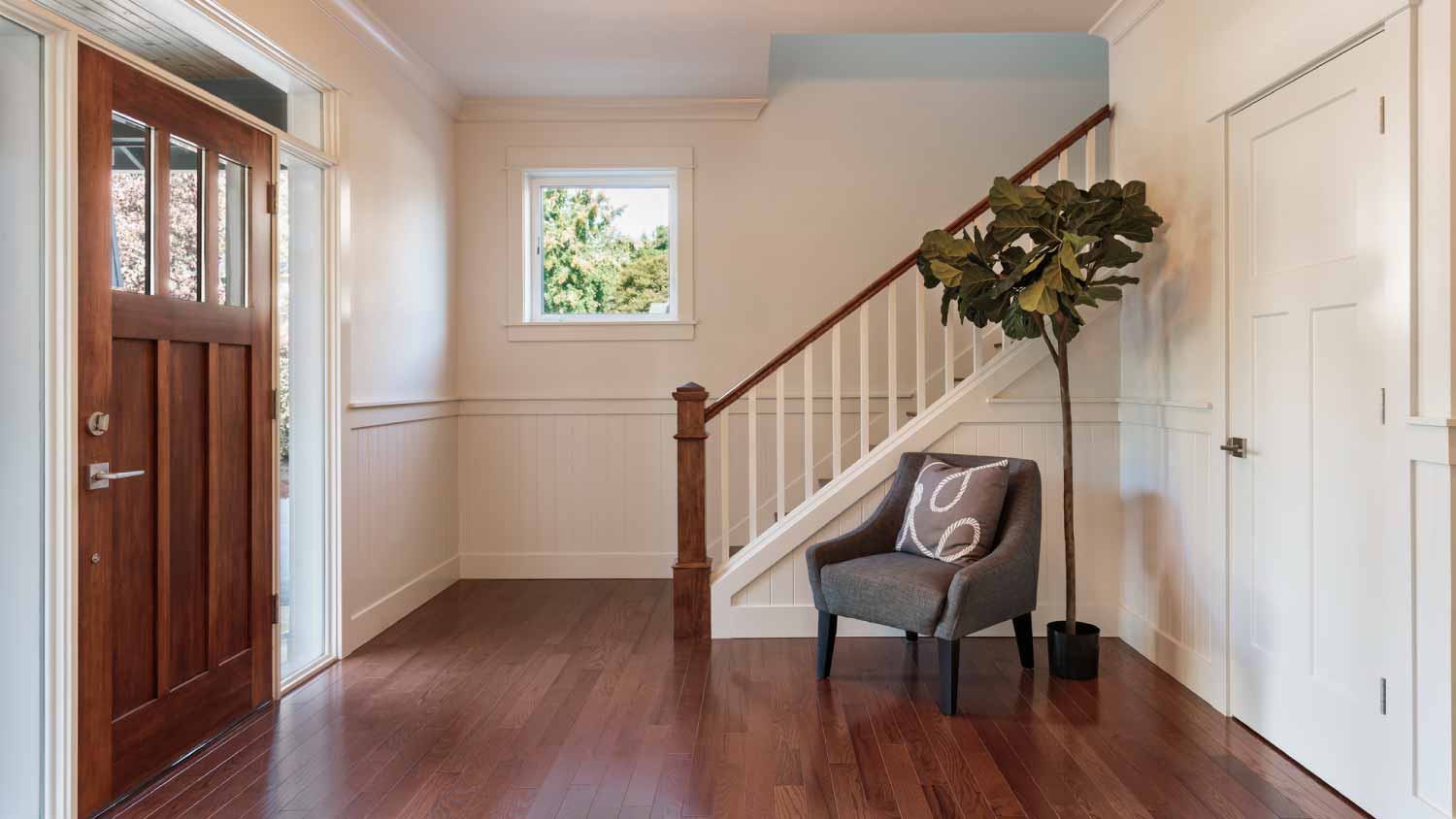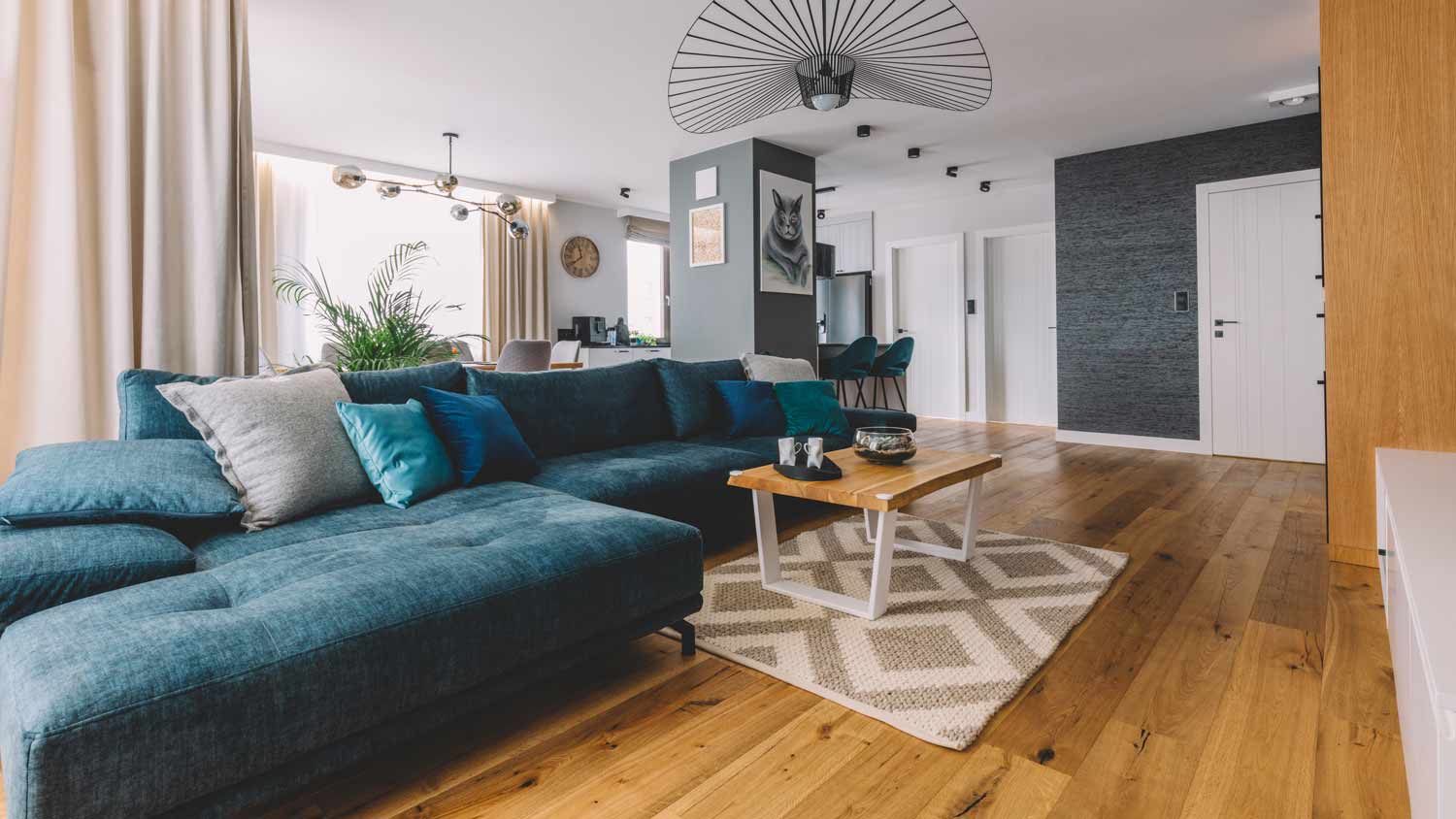How Much Do Heated Floors Cost? [2025 Data]
The average cost to install a heated floor is $4,128, but it can cost between $200 and $14,000, depending on the type of system and square footage.


It's a cold winter morning, and you head to the bathroom to get ready for the day. But when your feet hit the bathroom tile, instead of recoiling at their frigidness, they're warm to the touch. Now that's a great way to start the day!
You can expect to pay between $1,653 and $6,656,or an average of $4,128, for a heated floor system. The price you pay ultimately depends on factors like the type of heated floor system, the type of flooring you have, and labor costs.
Heated flooring is more than just an alternative method of heating your home—it has luxurious bonuses like the scenario above, and it's not as expensive as you might think.
Heated Floor Cost Breakdown

While the average cost for a radiant floor heating system falls between $1,653 and $6,656, many factors impact the total heated floor cost. The size of your surface area, type of flooring, and type of radiant floor heating system are some of the biggest factors, but you’ll want to consider all of the following as you budget for your project.
Cost per Square Foot
Expect to pay between $6 and $20 per square foot for your floor heating system. That means that the average 2,300-square-foot home will cost anywhere from $13,800 to $48,000 to heat the entire house. Most homeowners heat a few key areas of the home to save money, however. You might choose to heat your bathroom, kitchen, and primary bedrooms, for example.
Type of Flooring
The cost to heat your floors can vary from $15 to $60 per square foot, depending on the type of existing flooring. Tile flooring costs between $20 and $40 per square foot on average, while laminate or hardwood flooring costs an average of $15 to $20 per square foot. Here’s a breakdown of the different prices per square foot, including installation.
| Type of Flooring | Average Cost (Per Square Foot) |
|---|---|
| Tile | $30 |
| Concrete | $22.50 |
| Laminate | $17.50 |
| Hardwood | $17.50 |
| Ceiling Panels | $55 |
Heated bathroom tile costs $20 to $40 per square foot and is one of the most popular radiant flooring options.
Concrete radiant flooring costs $15 to $30 per square foot. The price largely depends on ease of access rather than the concrete itself.
Laminate radiant flooring costs between $15 and $20 per square foot and isn’t as good of a heat conductor as tile.
Hardwood radiant flooring costs $15 to $20 per square foot. If you choose a hydronic system and it leaks, there’s a risk of mold and rotting.
Whether you decide to seal grout or install a water-resistant vinyl, waterproofing your flooring is crucial, especially in rooms like bathrooms or the kitchen. A flooring pro can recommend the best materials for specific areas, install new flooring, and ensure it will stand up to water.
Ceiling Panels
Radiant ceiling panels cost between $50 and $60 per square foot on average. Lower voltage and lower wattage panels are the most budget-friendly options, while higher voltage and wattage panels fall higher on the price range.
Type of Heated Floor
The type of radiant floor heating system you choose plays a big role in the total cost of your heated floors. Propane flooring costs the least, while hydronic systems tend to cost the most—coming in at $6 to $20 more per square foot than some of the most budget-friendly options.
| Type of Heated Floor | Cost per Square Foot |
|---|---|
| Propane | $6 – $18 |
| Hydronic | $6 – $20 |
Labor
Heated floors cost between $550 and $2,500 for labor. Heated floors can take a team of professionals to install correctly—including plumbers, floor installers, and electricians. Here’s the breakdown for labor:
Plumbers: If you’re installing a new boiler or water heater, you’ll need a plumber. Hiring a plumber to install the pipes for the heated flooring costs anywhere from $45 to $200 per hour.
Floor installers: The average rate for floor contractors is between $100 to $150 per hour.
Electricians: Hiring an electrician costs $50 to $100 per hour. You might need an electrician to connect your new radiant floor heating system to the thermostat.
Keep in mind that every 1,000 square feet you plan on heating is roughly 12 hours of labor.
Site Prep
Hiring a flooring installer to remove your floors will run you between $60 and $120 per hour. There’s no way around it—preparing your home for the installation can be a bit of a grueling process, especially if you decide to remove your existing flooring yourself. You can save on-site prep expenses by DIYing it, but you’ll spend more on time and energy.
Debris Disposal
No one likes taking out the trash, but when it comes to tossing out your existing floors or removing waste from a geothermal heat pump excavation, you’ll need to factor in these costs. Debris disposal costs anywhere from $100 to $600 per truckload. If you opt for renting a dumpster in your area, you’ll want to tack on an additional $300 to $600 per week.
Location
As you may know from other home improvement projects, installation in hard-to-reach areas of the home will cost more than easy-to-reach areas. Namely, your garage or ground floor will cost significantly less than your basement or ceiling panels.
You’ll spend around three to five times more for ceiling panels compared to other types and $3,100 to $13,200 more to install radiant heat flooring in your basement compared to your garage—even if they’re both concrete.
Heated Floor Installation Costs by Type
When deciding what type of flooring is right for your home, radiant floor heating might be a top contender. But the amount you’ll end up paying ultimately depends on what type of radiant heating you choose. Here are four of the most popular types of radiant heating.
“For electric radiant heating materials, a good rule of thumb is $10 to $15 per square foot,” says Bob Tschudi, Angi Expert Review Board Member and general contractor in Raleigh, NC. “Add $5 to $10 per square foot for installation.”
| Radiant Floor Type | Average Cost |
|---|---|
| Electric | $19,000 – $36,000 |
| Hydronic | $19,000 – $48,000 |
| Geothermal In-Floor | $9,500 – $27,000 |
| Solar | $8,000 – $19,500 |
| Propane Underfloor | $2,400 – $2,900 |
Electric Radiant Floor Heat
An electric radiant floor will cost $19,000 to $36,000. Typically, these floor heating systems use strips of electrical matting that go across the subfloor, which are then set in mortar. These systems are particularly good for heating individual parts of the floor.
Hydronic Radiant Floor Heating
Hydronic radiant systems cost between $19,000 and $48,000 for a whole-home system. Hydronic systems work by using a hot-water heater or boiler to heat water. Once the water heats, it travels through pipes to heat up your home. Since water retains heat better than electric baseboards, this option is one of the most energy-efficient systems for heating floors.
Geothermal In-Floor Heating
Geothermal systems cost $9,500 to $27,000. These systems use thermal energy along with heat pumps to spread natural heat underneath the floor. They use a series of pipes under the floors that circulate hot water. These systems are particularly cost-effective to run and they’re eco-friendly, as they are low-maintenance and don’t burn fossil fuels.
Solar Radiant Heating
If you want a solar radiant system, it will cost $8,000 to $19,500. With this system, solar panels store energy from the sun and heat a fluid that is piped through a tank, and then circulated underneath the flooring.
Propane Underfloor
A propane system is your most affordable option at $2,400 to $2,900. As the name implies, this system uses propane as the energy source for heating the flooring.
Additional Costs to Consider
In addition to the underfloor heating system materials and installation costs, other expenses you should consider before moving forward with radiant heated floor include:
New Water Heater, Heat Pump, or Boiler Installation: A hydronic radiant flooring heating system requires a water heater, heat pump, or boiler. If your current setup doesn’t meet the new system’s needs, you’ll need to replace it.
Radiant Cooling: If you live in a hot climate, you can install a radiant cooling system along with radiant heat. These cool floors and ceilings by absorbing heat radiating throughout the room or circulating cooled water through pipes.
Thermostat and Temperature Zones: Location-specific thermostats divide your flooring into temperature zones that operate independently, helping save energy. However, they come with an added upfront cost.
Operating Costs: You should factor in the energy cost of using your system as you would with any upgrade to your home’s heating and cooling.
Maintenance Costs: Ongoing maintenance will keep your system running well. You’ll need to inspect and clean the electrical components of your system annually. You should also conduct boiler or water heater inspections, system flushing, and water-quality monitoring on hydronic systems.
Pros and Cons of Heated Floors
Radiant floor heating systems are popular because the pros often outweigh the cons, but they fit some homes and lifestyles better than others.
| Pros | Cons |
|---|---|
| Low operating cost | Expensive to install |
| Energy efficient | Almost impossible to install under existing flooring |
| Uniform heating in rooms and homes | Raises floor height |
| Low maintenance | Requires professional installation |
Pros
There’s so much to love about radiant floor heating. These are some of the best perks.
Energy efficient: Radiant floor heating is one of the most energy-efficient ways to heat a home. In fact, they can be up to 25% more efficient than traditional forced-air heating systems.
Uniform heating: Radiant floors naturally distribute heat throughout the installation area, evenly heating all areas of the room, unlike forced air or baseboard heat that is hotter at the source or next to the heater.
Low operating cost: Heated floors can cost as little as $1 a day to power.
Installation options: Radiant heating can be installed on floors, ceilings, and walls, making it flexible and adaptable to a variety of homes, businesses, and buildings.
Multiple options for heating sources: While electric and hydronic are the most common, radiant flooring is compatible with multiple other sources of heat, including geothermal and solar.
Zone heating: You can designate rooms and areas of your home as zones, each connected to its own thermostat. Zones can be separated by different types of flooring, flooring transition strips, or have no visible separation at all.
Low maintenance: Electric-powered radiant heat systems only require maintenance cleaning. Hydronic systems require water line flushing and water testing, but it’s still minimal compared to other types of heaters.
Quiet: Radiant heating is nearly silent since it doesn’t rely on a furnace or airflow to heat rooms.
Last longer than other heat sources: Radiant floors can last 25 years or longer as long as the flooring on top of them is in good shape. On the other hand, HVAC units usually last between 10 and 20 years.
Doesn’t require ductwork: Forced-air systems can require all-new ducting, even if you’re replacing an existing system. Radiant heating systems don’t use air ducts, so there’s no chance of leaking ducts or wasted hot air.
Better for people with allergies and asthma: According to the U.S. Department of Energy, radiant floor heating doesn’t distribute allergens like forced air systems do.
Cons
For all the good, there are a few things that can be considered cons when looking at radiant flooring.
Expensive to buy and install: Initial costs to purchase and install can be higher for radiant heating than for other types of heating systems. This is particularly true for hydronic systems, which usually require a boiler, pump, and gas lines.
Hard and expensive to install in rooms that already have flooring: It’s almost impossible to install radiant heating in areas that already have floors. You’ll need to pay to tear up existing flooring, place the heating system, and then install new flooring on top.
Change the floor height: Radiant heating will raise the height of floors by about 1 inch since they sit between the flooring and subflooring. This can be a problem if swinging doors don’t clear the flooring or in rooms with cabinets and other items already in place.
Not usually a DIY task: Most radiant flooring requires professional installation.
Cost to Install Heated Floors Yourself

You can buy your own materials, but installing radiant floor heating is something you will still need to hire a professional to do if you don't have the know-how. Most of these jobs require permits—work that must be done by a licensed contractor. This is potentially dangerous work due to its electrical nature, making it a DIY no-no. Plus, you might make some expensive mistakes—assuming you even have the tools needed to do the job.
The average price per square foot is $11 for a professional installation. This includes the cost of new flooring materials, $6 for DIY electric system materials, and $2 for hydronic system materials.
Cost of Hiring a Pro to Install Heated Floors vs. DIY
You can save around $4 per square foot if you DIY your electric floor heating system and $9 per square foot if you DIY a hydronic radiant heating system.
Again, if you don’t have experience installing heated floors, it’s best to leave this project to a qualified flooring contractor near you. Attempting to install it yourself involves electrical work, which can pose electrical and fire hazards to your household if improperly installed. Before hiring, be sure to get multiple quotes so you can compare.
7 Ways to Save on Heated Floor Installation Costs
With such high upfront costs, finding ways to save on the cost of your heater floors might be on the top of your priority list. Try out the following tips to save money:
Heat the most important areas of your home to avoid paying for more square footage.
Choose a more affordable heater floor system, like propane.
Do as much site prep yourself as possible to avoid paying extra to hire a professional for tasks you can do yourself. However, discuss this with your contractor so you don’t inadvertently create more work for them.
If you have experience installing heater floors, you can save by DIYing it. Just be certain you have the qualifications, expertise, and licensing to meet all electrical code requirements and do the work safely.
Check federal tax credit requirements through the Inflation Reduction Act to potentially receive 30% off a geothermal heat pump system.
See if you’re eligible for 22% savings via federal solar tax credits.
Check if your local or state government offers rebates for solar or geothermal systems.
How Angi Gets Its Cost Data
Home is the most important place on earth, which is why Angi has helped more than 150 million homeowners transform their houses into homes they adore. To help homeowners with their next project, Angi provides readers with the most accurate cost data and upholds strict editorial standards. We extensively research project costs to develop the pricing data you see, so you can make the best decisions for you and your home. We rely on reputable sources, including the U.S. Bureau of Labor Statistics, academic journals, market studies, and interviews with industry experts—all to ensure our prices reflect real-world projects.
Want to help us improve our cost data? Send us a recent project quote to costquotes@angi.com. Quotes and personal information will not be shared publicly.
Frequently Asked Questions
Though they have a high upfront cost, it can be worth it to upgrade to heated floors. You’ll save money on your energy bills, increase your home’s resale value, and feel more comfortable in your home. If you live in a warm climate, however, it might be less worthwhile to take the plunge.
Heated floors use less electricity than traditional heating systems. The average electric bill for running radiant floor heating nonstop is around $3 per day. For example, a 1,500-watt electric space heater costs around $4.80 per day, a 27,000-BTU electric boiler costs around $6.25 per day, and a 100,000-BTU electric heater costs $46 per day.
Heated floors are unlikely to cause mold. In fact, they can help prevent mold growth. The additional heat helps dry excess water and reduce condensation, which can lessen the likelihood of mold growth. Additionally, the heated floors can help reduce humidity near the bottom of the floor.
Heated floors can last anywhere from 35 to 50 years with proper maintenance and high-quality existing floors. Many radiant floor heating systems also come with 25-year warranties. Keep in mind that some types of floor heaters need replacement parts. For example, hydronic radiant floor heaters need a new boiler and heat pump every 15 to 20 years.
The best floor type for radiant heating is tile. Porcelain, ceramic, and natural stone are the best tile options because they’re excellent heat conductors, won’t mold or rot if your hydronic system ever leaks, and don’t pose a fire safety in the off chance your heating system overheats like with wood flooring. For radiant concrete slabs, it’s smart to first install a vapor barrier to prevent moisture in concrete and condensation, especially in basements.

.jpg?impolicy=leadImage)















